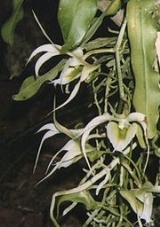
Aeranthes
Encyclopedia
Aeranthes, abbreviated Aerth in the horticultural trade, is an orchid genus
with 47 species, mostly from shady, tropical humid forests in Zimbabwe
, Madagascar
and islands in the Western Indian Ocean
. The name "aeranthes" means 'aerial flower', because it grows high in the air.
Aeranthes has a single short, erect, monopodial
stem
. The leathery, shining, opposite leaves
are arranged in two rows of five to seven leaves, with a length of 15–25 cm. New leaves are formed at the top of the stem in a monopodial
growth pattern.
The threadlike flower
stalk grows downward to a length of almost 30 cm. It carries one or two almost translucent, greenish yellow flowers. The sepal
s and the shorter petal
s taper off into five long, narrow shoots. Some give an agreeable, sweet scent in the evening or early morning.
Genus
In biology, a genus is a low-level taxonomic rank used in the biological classification of living and fossil organisms, which is an example of definition by genus and differentia...
with 47 species, mostly from shady, tropical humid forests in Zimbabwe
Zimbabwe
Zimbabwe is a landlocked country located in the southern part of the African continent, between the Zambezi and Limpopo rivers. It is bordered by South Africa to the south, Botswana to the southwest, Zambia and a tip of Namibia to the northwest and Mozambique to the east. Zimbabwe has three...
, Madagascar
Madagascar
The Republic of Madagascar is an island country located in the Indian Ocean off the southeastern coast of Africa...
and islands in the Western Indian Ocean
Indian Ocean
The Indian Ocean is the third largest of the world's oceanic divisions, covering approximately 20% of the water on the Earth's surface. It is bounded on the north by the Indian Subcontinent and Arabian Peninsula ; on the west by eastern Africa; on the east by Indochina, the Sunda Islands, and...
. The name "aeranthes" means 'aerial flower', because it grows high in the air.
Aeranthes has a single short, erect, monopodial
Monopodial
Vascular plants with monopodial growth habits grow upward from a single point. They add leaves to the apex each year and the stem grows longer accordingly...
stem
Plant stem
A stem is one of two main structural axes of a vascular plant. The stem is normally divided into nodes and internodes, the nodes hold buds which grow into one or more leaves, inflorescence , conifer cones, roots, other stems etc. The internodes distance one node from another...
. The leathery, shining, opposite leaves
Leaf
A leaf is an organ of a vascular plant, as defined in botanical terms, and in particular in plant morphology. Foliage is a mass noun that refers to leaves as a feature of plants....
are arranged in two rows of five to seven leaves, with a length of 15–25 cm. New leaves are formed at the top of the stem in a monopodial
Monopodial
Vascular plants with monopodial growth habits grow upward from a single point. They add leaves to the apex each year and the stem grows longer accordingly...
growth pattern.
The threadlike flower
Flower
A flower, sometimes known as a bloom or blossom, is the reproductive structure found in flowering plants . The biological function of a flower is to effect reproduction, usually by providing a mechanism for the union of sperm with eggs...
stalk grows downward to a length of almost 30 cm. It carries one or two almost translucent, greenish yellow flowers. The sepal
Sepal
A sepal is a part of the flower of angiosperms . Collectively the sepals form the calyx, which is the outermost whorl of parts that form a flower. Usually green, sepals have the typical function of protecting the petals when the flower is in bud...
s and the shorter petal
Petal
Petals are modified leaves that surround the reproductive parts of flowers. They often are brightly colored or unusually shaped to attract pollinators. Together, all of the petals of a flower are called a corolla. Petals are usually accompanied by another set of special leaves called sepals lying...
s taper off into five long, narrow shoots. Some give an agreeable, sweet scent in the evening or early morning.

